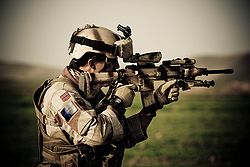This article has multiple issues. Please help improve it or discuss these issues on the talk page . (Learn how and when to remove these messages)
|

An infrared flag (or IR flag) is a type of combat identification used by soldiers. They consist of a national flag or other identifying icon with a Velcro backing for application to a soldier's uniform on the upper arm or chest.